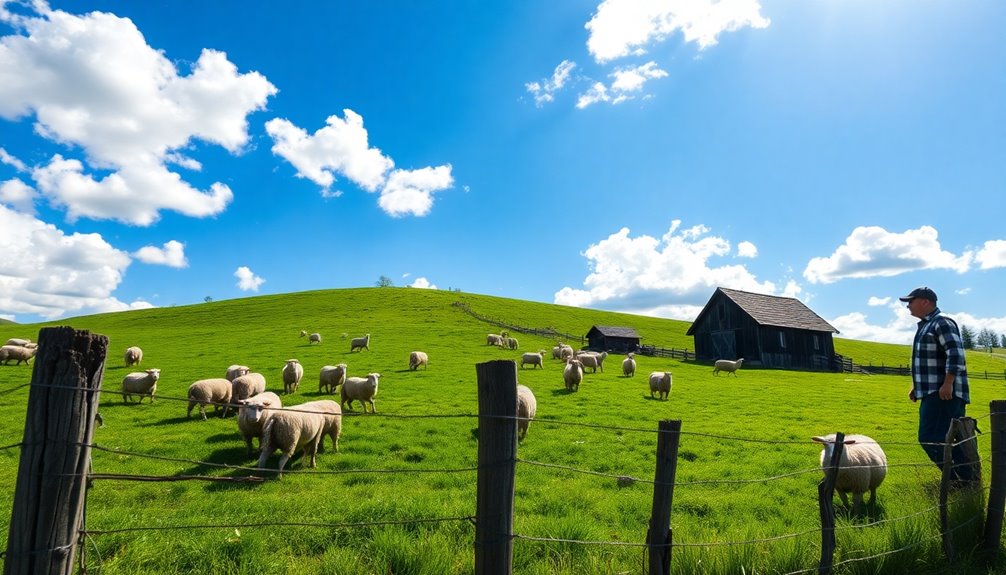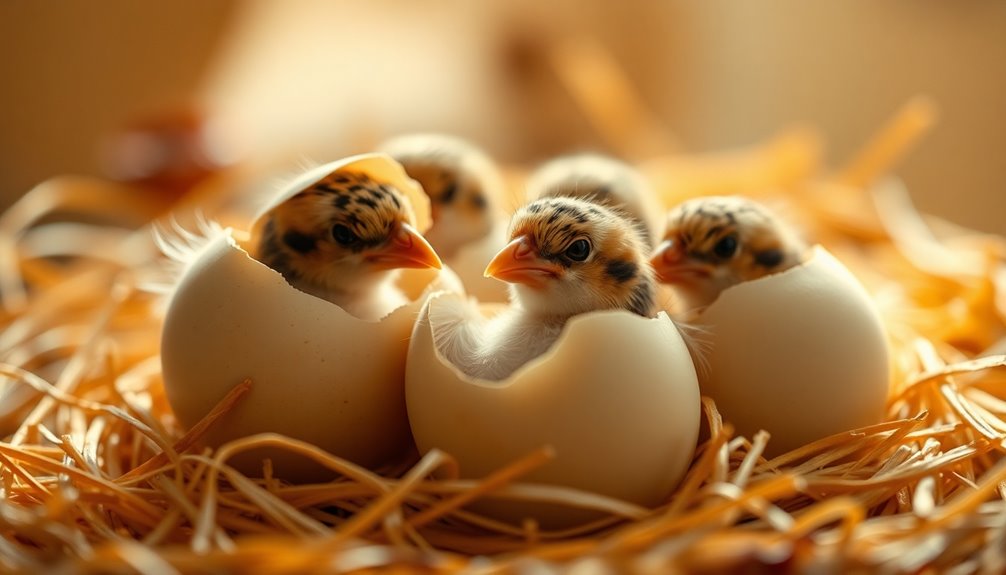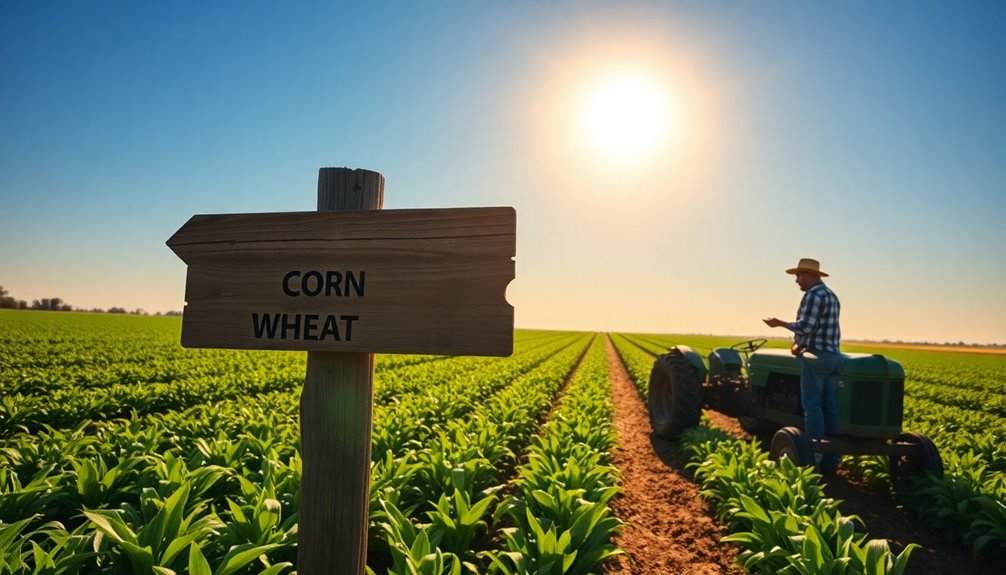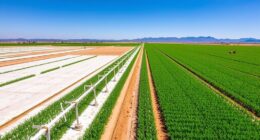Starting a sheep farm is a rewarding way to engage in agriculture. You need to choose the right breed based on your goals, whether for meat, wool, or milk. Aim for a minimum flock size of five for companionship. Focus on essential flock management practices like health monitoring, balanced nutrition, and proper shelter. Daily health inspections and vaccinations are vital to your flock's well-being. Incorporating sustainable practices will enhance your farming experience. If you want to guarantee a successful venture, there's plenty more to explore about managing your flock effectively and efficiently.
Key Takeaways
- Select suitable sheep breeds based on your climate and farming goals, considering meat, wool, or milk production.
- Establish a health management routine, including daily inspections, vaccinations, and tailored deworming practices.
- Provide a balanced diet, adjusting for seasonal changes, and focus on nutrition during late pregnancy and lactation.
- Implement sustainable practices like rotational grazing and manure management to enhance pasture health and soil fertility.
- Monitor breeding and lambing carefully, ensuring proper care for ewes and newborns during and after birth.
Getting Started With Sheep
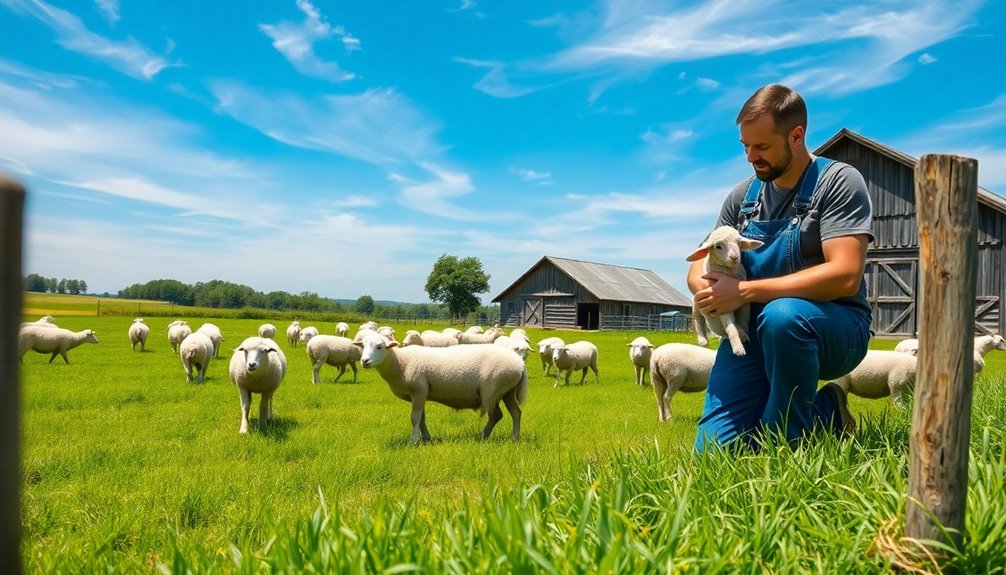
When you plunge into sheep farming, starting off with a solid foundation is vital. You should aim for a minimum flock size of five sheep, as they thrive better with companionship and security.
Choose breeds of sheep that suit your local climate and your farming goals, whether that's for meat, wool, or milk production. Daily care routines are important; inspect their health, count the flock to guarantee everyone's present, and watch for any signs of illness.
Strong, secure fencing is a must, since sheep are known escape artists, especially during mating season.
Finally, establish a relationship with your local vet for professional health support, making certain your flock of sheep receives the care they need in emergencies and routine check-ups.
Choosing the Right Breed
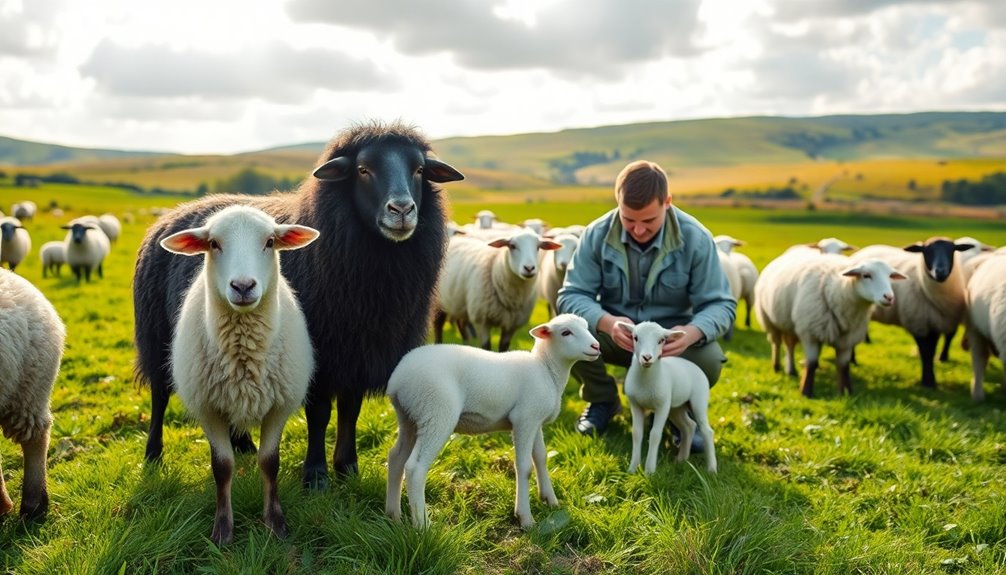
Selecting the right breed of sheep is a key step in establishing a successful flock. Start by considering your primary purpose—whether it's for meat, wool, or milk. Look for breeds that suit your local climate, like heritage breeds such as Shetlands, which excel on pasture. Breeds from the Conservation Priority List, like Katahdins, support biodiversity while reducing extinction risk.
| Purpose | Example Breed | Key Trait |
|---|---|---|
| Meat | Suffolk | Rapid growth |
| Wool | Merino | Fine wool production |
| Milk | East Friesian | High milk yield |
Choose breeds that align with your management style, especially if kids are involved, and consider traits like parasite resistance in hair sheep, such as St. Croix, to make raising sheep easier.
Essential Flock Management Practices
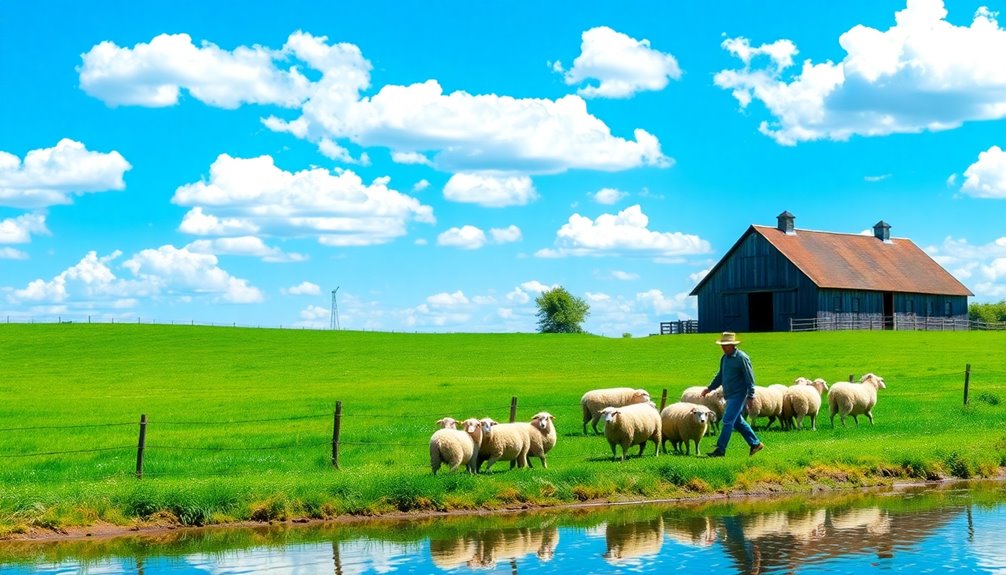
Effective flock management practices are essential for maintaining the health and productivity of your sheep. Start with daily health inspections to catch any signs of illness early, ensuring your flock stays well.
Incorporate nutritional supplements, especially for pregnant and lactating ewes, to support ideal growth and reproduction. Regular hoof trimming, usually once a year, helps prevent foot-related diseases, keeping your sheep healthy and mobile.
It's also important to maintain detailed breeding records, health checks, and vaccination schedules, as these enhance your management and track productivity over time.
Finally, implement rotational grazing practices to improve pasture health, reduce parasite exposure, and maximize forage availability for your flock. These practices will set you up for success in sheep farming.
Nutrition and Feeding Requirements
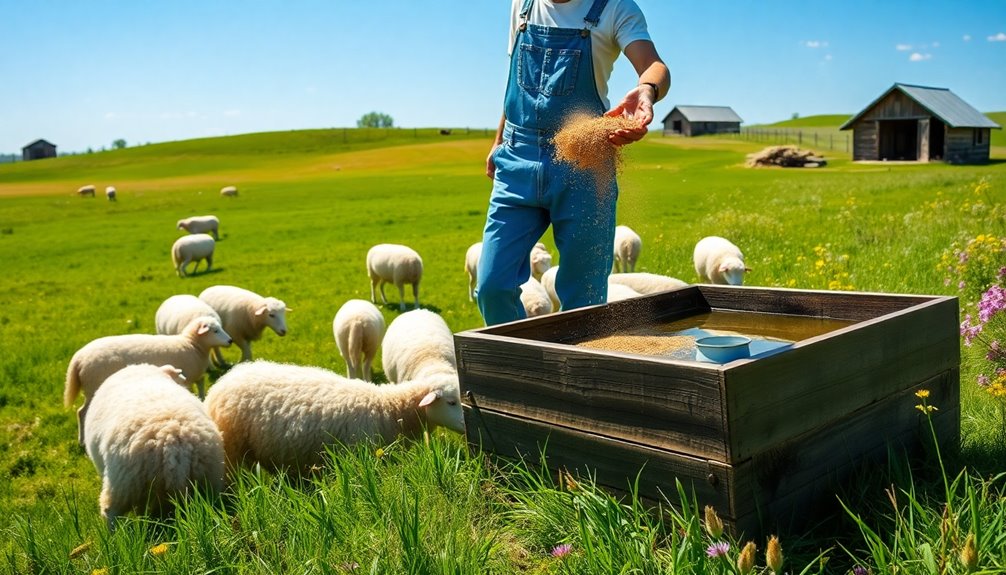
To keep your sheep healthy and productive, you need to guarantee they've a balanced diet tailored to the season.
During the growing season, rely on pasture, while high-quality hay is essential in winter.
Pay special attention to their nutritional needs during late pregnancy and lactation to support both ewes and their lambs.
Balanced Diet Essentials
A well-balanced diet is essential for the health and productivity of your sheep. During the summer months, provide high-quality grass, while offering high-quality hay from Christmas to Easter.
For lactating ewes, start supplementary feeding six weeks before lambing to meet their peak nutritional needs. Introducing grains can support their diet, but do it gradually and limit to two pounds per day per animal to prevent rumen upset.
Don't forget to supply loose minerals tailored for sheep, as their copper requirements differ from goats. Regularly monitor forage quality, as it greatly impacts your flock's health.
Before purchasing sheep, source hay and consider quality testing to verify you're meeting their dietary requirements effectively.
Seasonal Feeding Strategies
While managing your sheep's nutritional needs throughout the year, it's vital to adapt your feeding strategies based on the seasons.
During summer, let your sheep graze on pasture, but come winter, supplement their diet with high-quality hay to guarantee they get the nutrition they need.
As ewes prepare to lamb, start feeding them ewe nuts six weeks prior to delivery to support their nutritional requirements during late pregnancy and lactation.
For adult sheep, spread supplementary food on clean grass to minimize waste, limiting it to a maximum of two pounds per day.
Don't forget to provide fresh water and free-choice loose minerals, as these are important for both adult sheep and lambs' needs.
Avoid alfalfa in hay feeders to maintain fleece quality.
Health Monitoring and Disease Prevention
Regular health monitoring is essential for maintaining a thriving sheep flock. You'll want to conduct routine health checks, looking for unusual behavior and signs of illness. Implementing the following practices can greatly enhance your flock's well-being:
- Regular vaccinations: Schedule vaccinations against tetanus and clostridial infections, starting with lambs at 6-8 weeks old.
- Deworming: Tailor your deworming practices to clinical symptoms, using regular fecal testing to assess parasite loads.
- Rotational grazing: Maintain clean living conditions to reduce parasite exposure and enhance overall health.
Don't forget to administer Heptavac injections to pregnant ewes to guarantee newborn lambs receive the immunity they need against common diseases.
Keeping up with these practices will help you prevent health issues and maintain a robust flock.
Shelter and Fencing Solutions
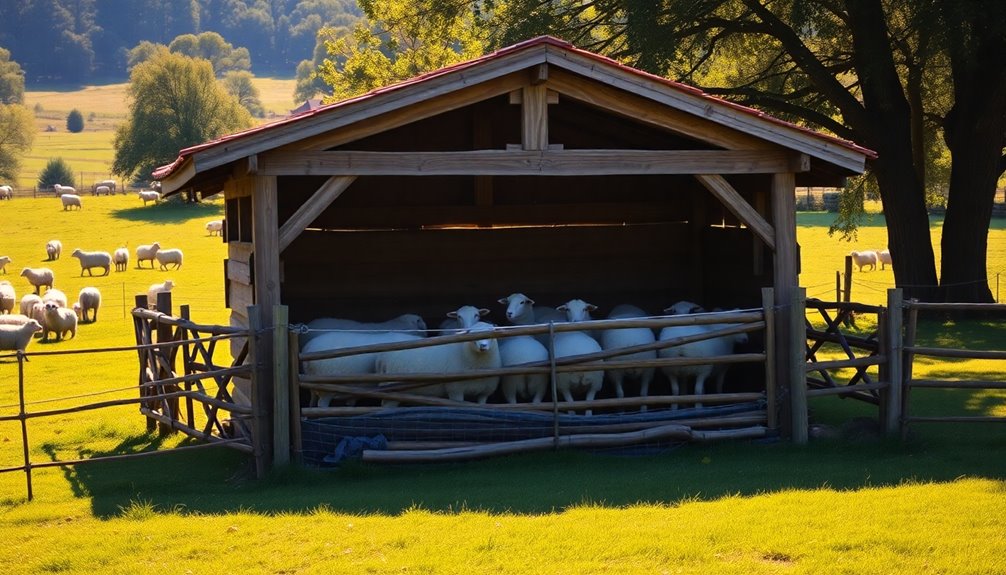
Providing adequate shelter and effective fencing is essential for your sheep's well-being and safety. Construct a simple three-sided shelter that protects them from rain, wind, and extreme temperatures, while allowing fresh air. This helps minimize respiratory issues and keeps your flock healthy.
For fencing, use high-tensile woven wire to deter predators effectively. Interior options like portable electric fencing offer flexibility for rotational grazing, ensuring your sheep access fresh pasture.
Don't forget to install water troughs designed specifically for sheep, making sure they're low enough for easy access. Regularly check your fencing's integrity, as sheep are curious and will escape if it's not secure, especially during active times like mating season.
Keeping these elements in mind will help you maintain a thriving flock.
Breeding and Lambing Considerations
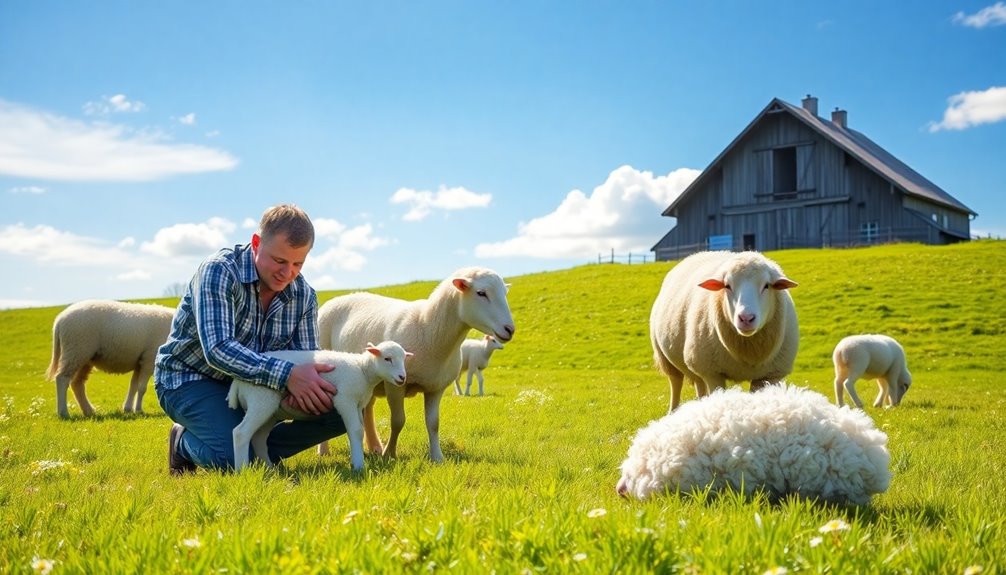
When it comes to breeding and lambing, timing is everything.
You'll want to plan for mating in November to align lambing with ideal grass and milk availability in April.
Additionally, using a raddle can help you track breeding dates and guarantee a smooth lambing season.
Optimal Breeding Practices
Successful sheep farming hinges on ideal breeding practices that guarantee both healthy ewes and thriving lambs. To enhance your breeding efforts, consider these key points:
- Timing: Aim for ewe pregnancy to begin in November, ensuring lambing season coincides with peak grass availability in April and May.
- Resource Management: Utilize one ram to effectively breed up to 40 ewes, maximizing your flock expansion.
- Tracking: Employ a raddle to mark mating dates, helping you manage your lambing schedule and expectations.
Additionally, focus on breeding for specific traits like birthing ease and mothering capabilities to enhance successful lambing outcomes.
Lambing Season Timing
Lambing season timing plays an essential role in the overall success of your sheep farming operation. For best results, you'll want to plan breeding so that lambs are born in spring, typically between April and early May.
Ewe pregnancy lasts about 147 days, meaning mating should occur in November. While some breeds, like Dorset sheep, can lamb year-round, most benefit from this seasonal timing, as spring brings abundant grass for ideal nutrition.
To keep track of breeding dates, consider using a raddle on the ram. Ewes generally give birth within 2-6 hours, so be prepared for complications like prolapses or breach births.
Common Challenges in Sheep Farming
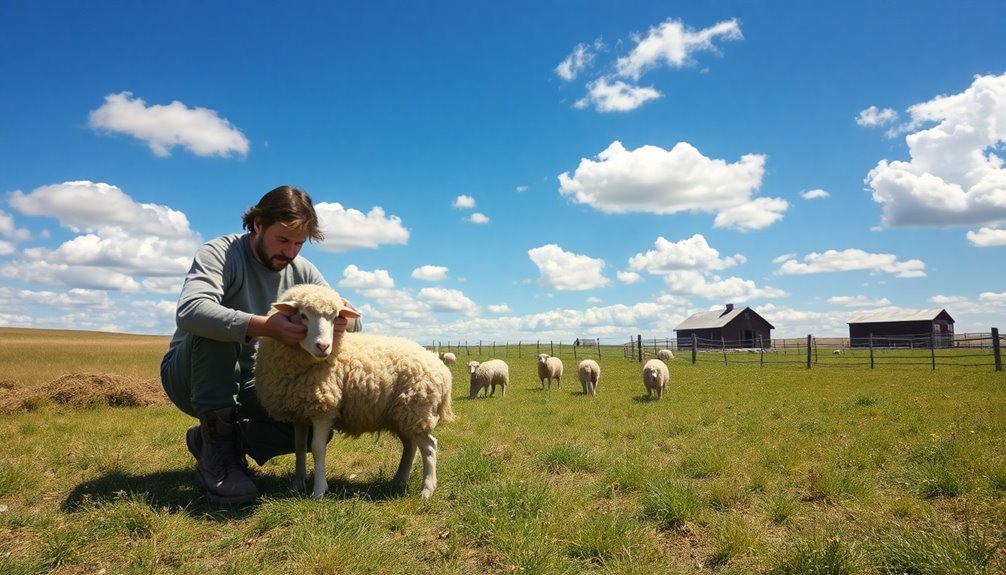
While sheep farming offers numerous rewards, it also comes with its share of challenges that can impact your flock's health and productivity.
You'll need to navigate common health challenges, particularly for vulnerable groups like newborn lambs and pregnant ewes.
Here are three key challenges you may face:
- Parasites: Regular deworming based on symptoms and fecal testing is essential for managing infestations.
- Vaccinations: Administering vaccines against tetanus and clostridial infections can prevent serious outbreaks.
- Weather Variability: Extreme conditions require effective shelter and management strategies to maintain flock health.
Benefits of Sheep Farming
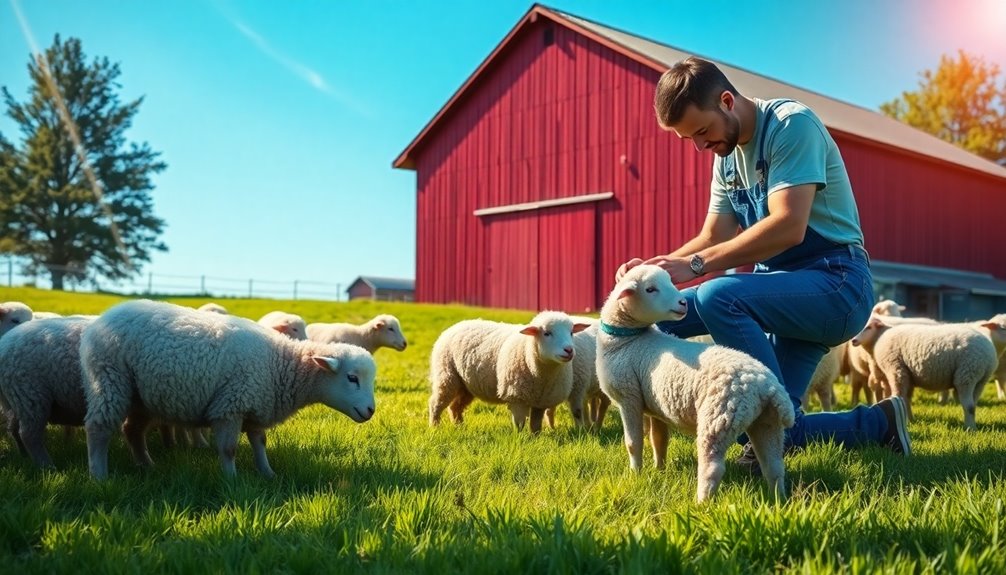
Sheep farming offers a wealth of benefits that can enhance both your livelihood and your connection to the land. By keeping sheep, you can tap into multiple income streams through the production of meat, wool, and milk.
Whether you manage a small flock or engage in commercial sheep farming, these breeds provide relatively low-maintenance livestock, making them perfect for novice farmers.
Additionally, grazing sheep improves pasture health by naturally controlling weeds and enriching soil through their manure. This sustainable farming practice fosters a deeper understanding of agriculture and strengthens your relationship with nature.
Plus, by connecting with community networks, you can share experiences and support sustainable initiatives, enriching both your knowledge and local agricultural practices.
Frequently Asked Questions
How Many Sheep Should a Beginner Start With?
When you're starting out, it's best to begin with at least 4 to 5 sheep. This size helps guarantee social companionship and improves their well-being.
You'll want to assess your pasture quality and local conditions, as one acre can typically support 3 to 5 sheep. Consulting local shepherds will give you valuable insights into the right flock size for your environment, allowing you to manage and grow your flock effectively over time.
How Many Sheep Can You Put on 1 Acre?
Imagine a lush, green pasture filled with happy sheep grazing under the sun.
You can typically put 3 to 5 sheep on 1 acre, but if your pasture's exceptional, you might stretch that to 6.
However, it's wise to approach this with care.
Keep in mind the land's condition and seasonal changes.
Consulting local shepherds can help you find the right balance for your area, ensuring your flock thrives.
What Is the Best Breed of Sheep for Beginners?
When you're starting out, the best breeds of sheep for beginners are hair sheep like Katahdins and Dorpers. They don't need shearing and are low-maintenance, making them easy for you to manage.
If you're interested in meat production, consider the Suffolk breed for its quick growth and quality.
For fiber enthusiasts, Merinos offer fine wool but require more care.
Always choose breeds suited to your local climate to guarantee success.
How Many Sheep Do You Need to Start a Farm?
To start a farm, you'll want a minimum flock size of 4-5 sheep. This guarantees they've companionship, which is essential for their well-being.
Generally, one acre can support 3-5 sheep, but it depends on pasture quality and local conditions. It's smart to consult local shepherds for specific recommendations.
Consider beginning with 5-10 sheep for manageable growth, allowing you to provide proper care and attention as you expand your flock.
Conclusion
So, you're ready to plunge into sheep farming, huh? Just imagine—hours of tending to your flock, dodging the occasional sheep tantrum, and figuring out why they think grass is gourmet. But hey, at least you'll have a steady supply of wool for those cozy sweaters you never wear! Embrace the chaos and laugh through the challenges; after all, who wouldn't want to trade their 9-to-5 for a life of bleating and hay bales? Welcome to the sheep life!

